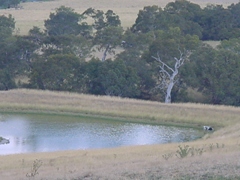
Water tanks, dams and channels on farms are an essential source of water for human and livestock drinking and irrigation needs. However they can pose serious risks. Children can drown in tanks and dams, water can be contaminated and accidents can happen when tanks are being cleaned.
Tanks can also become breeding areas for mosquitoes which is a particular concern in areas where mosquito borne diseases like Murray Valley encephalitis virus, Ross River virus, Barmah Forest virus and Dengue fever are a risk.
Protect yourself and others:
Seal water tanks so children, animals, birds and insects can’t get in.
Monitor and clean water tanks regularly. Ensure you use appropriate safety precautions; ie make sure someone knows you are in there and be careful using motorised pumps in confined spaces such as tanks — people have become asphyxiated.
Ensure there is a safe and fenced off play area for children and always keep an eye on children near dams, troughs swimming pools, creeks and tanks.
If you obtain your drinking water from bores, rivers, dams or rainwater tanks, you should take special care to make sure that this water is safe to drink. Contaminated water can cause serious illness, from nutrient build up, bacteria, agrichemicals, bushfire ash and algal blooms such as blue green algae. Water from hoses can also be dangerous particularly if it has been sitting in the hose and becomes warm thus enabling bacteria build up.
Fast Facts – Water tanks and dams – safety tips
- Seal drinking water tanks
- Clean out tanks regularly
- Do not drink from your water if you think it is contaminated
- If treating water ensure you follow the directions
References used for this topic
More information:
Better Health Channel
Water quality in tanks, bores and dams
ABC News
Carbon monoxide poisoning suspected in deaths of three people in Gunning water tank
Department of Health (Australia)
Emergency chlorination of farm water Last updated: January 2020
Queensland Health
Safe water on rural properties
Research & reviews:
NHMRC
Australian Drinking Water Guidelines 6 2011 Version 3.5 Updated May 2019
|
|